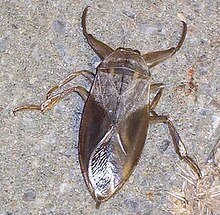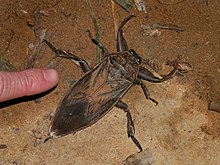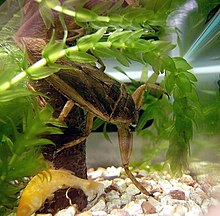Lethocerus
| Lethocerus | |
|---|---|

| |
| Lethocerus americanus | |
| Scientific classification | |
| Kingdom: | Animalia |
| Phylum: | Arthropoda |
| Class: | Insecta |
| Order: | Hemiptera |
| Family: | Belostomatidae |
| Subfamily: | |
| Genus: | Lethocerus , 1853 |
| Species | |
|
See text | |
Lethocerus is a genus of the hemipteran family Belostomatidae, known colloquially as giant water bugs, distributed in tropical, subtropical and temperate areas of the world.[1][2] The greatest diversity of species occurs in the Americas, with only a single species in Europe, two in Africa, two in Australia and three in Asia.[2] It includes the largest true bugs with species capable of reaching a length of over 12 centimetres (4.7 in).[3] The South American L. grandis and L. maximus are the only species to commonly exceed 9 cm (3.5 in), with more typical lengths for the remaining species being between 4.5 and 9 cm (1.8 and 3.5 in).[2] Lethocerus sp. are distinguished from other genera in the (Benacus and Kirkaldyia) by two symmetrical furrows in the inner pad of setae on the fore femur, the external borders of parasternites II and III narrowed and nearly straight, and with the setae of the tarsomeres following the line of the tibial setae.
Habits[]

Unlike giant water bugs in the subfamily Belostomatinae, females do not lay the eggs on the backs of males.[4] Instead, after copulation (often multiple sessions[5]) the eggs are laid on emergent vegetation (rarely on man-made structures) high enough above the waterline that the eggs will not be permanently submerged. The male then guards the eggs from predators and periodically brings water to the eggs to prevent their desiccation.
Like other members of the giant water bug family, Lethocerus species are predators that overpower prey by stabbing it with the rostrum and injecting a venomous saliva. The rostrum can also be used in self-defense, and the bite is very painful to humans, but usually resolves within a few hours at most.[3]
Species[]


As of 2006, this is an exhaustive listing of all known species of Lethocerus:[2]
The oldest known fossil of the genus is an indeterminate species from the Bembridge Marls, Isle of Wight, UK.[6]
In addition to these, Lethocerus deyrollei, which is one of the best known giant water bugs, has traditionally been included in this genus, but in 2006 it was moved to Kirkaldyia.[2]
| Wikimedia Commons has media related to Lethocerus. |
References[]
- ^ D. R. Lauck & A. Menke (1961). "The higher classification of the Belostomatidae (Hemiptera)". Annals of the Entomological Society of America. 54: 644–657.
- ^ Jump up to: a b c d e f g P. J. Perez-Goodwyn (2006). "Taxonomic revision of the subfamily Lethocerinae Lauck & Menke (Heteroptera: Belostomatidae)". . A (Biologie). 695: 1–71.
- ^ Jump up to: a b Haddad Jr; Schwartz; Schwartz; and Carvalho (2010). Bites Caused by Giant Water Bugs Belonging to Belostomatidae Family (Hemiptera, Heteroptera) in Humans: A Report of Seven Cases. Wilderness & Environmental Medicine 21: 130–133.
- ^ Ichikawa, Noritaka (1988). "Male brooding behaviour of the giant water bugLethocerus deyrollei vuillefroy (Hemiptera: Belostomatidae)". Journal of Ethology. 6 (2): 121–127. doi:10.1007/BF02350877. ISSN 0289-0771.
- ^ Ichikawa, Noritaka (1989). "Repeated copulations benefit of the female in Lethocerus deyrollei vuillefroy (Heteroptera: Belostomatidae)". Journal of Ethology. 7 (2): 113–117. doi:10.1007/BF02350032. ISSN 0289-0771.
- ^ Szwedo, Jacek; Drohojowska, Jowita; Popov, Yuri A.; Simon, Ewa; Wegierek, Piotr (September 2019). "Aphids, true hoppers, jumping plant-lice, scale insects, true bugs and whiteflies (Insecta: Hemiptera) from the Insect Limestone (latest Eocene) of the Isle of Wight, UK". Earth and Environmental Science Transactions of the Royal Society of Edinburgh. 110 (3–4): 331–396. doi:10.1017/S175569101900001X. ISSN 1755-6910.
- Nepomorpha genera
- Belostomatidae
- Hemiptera of North America